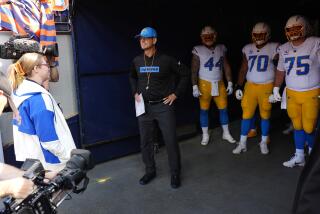The frightening frequency of heart attacks in soccer
A few hours before a wary Landon Donovan ran onto the practice field at the Home Depot Center on Thursday, a funeral took place in Bergamo, Italy.
And those two events may have more in common than you think.
Piermario Morosini, a 25-year-old midfielder for Livorno in Italy’s Serie B, collapsed and died of cardiac arrest in the first half of his team’s match last weekend. He was laid to rest Thursday, with thousands of fans packing the streets of his hometown as his coffin, draped in numerous jerseys passed.
Half a world away Donovan, a 30-year-old midfielder for the Galaxy, was still wondering how that had happened.
“It’s scary,” Donovan said. “We want to know what’s going on. I’m by no means an expert in any of this, but if there’s something that’s preventable, then we need to prevent it. We can’t keep letting this happen.”
It has been happening with alarming regularity.
Four days before Morosini was buried, 23-year-old Fabrice Muamba was released from the London hospital where he had spent a month after suffering a near-fatal cardiac arrest of his own. A midfielder for Bolton of the English Premier League, Muamba’s heart stopped beating on its own for more than 78 minutes. He collapsed during the first half of an FA Cup match with Tottenham at White Hart Lane.
Less than a week after Muamba was brought back to life, D. Venkatesh, a 27-year-old midfielder for Indian A division club Bangalore Mars, collapsed and died near the end of a match on his team’s home pitch in southern India.
Donovan was so spooked by Morosini’s death that he sought out members of the Galaxy’s medical staff for a long talk before a game with Portland last weekend.
Armando Rivas, the Galaxy’s head athletic trainer, said he welcomed the questions.
“It’s actually a way of opening that conversation with these guys,” he said. “It’s really kind of something for our profession to focus on and go, ‘OK, let’s communicate. Are we doing everything we can?’ And it opens this conversation for us to evaluate what we’re doing. And to push each other.”
Major League Soccer already has one of the most extensive medical screening procedures in U.S. professional sports. It requires all players to undergo EKGs and echocardiograms before each season. The results are evaluated by physicians on site then sent to the league office where they are reviewed again.
Two years ago, those exams showed that defender Zachary Herold, Toronto FC’s top pick in the 2010 SuperDraft, had hypertrophic cardiomyopathy (HCM), leaving him at risk of developing a potentially fatal irregular heart rhythm. So Herold retired from soccer — at the age of 17.
In addition to the pre- and postseason physicals, the vast majority of the league’s 19 teams — the Galaxy and Chivas USA among them — also use wireless heart-rate monitors about the size of a credit card to track players’ reactions to in-season training.
“We have certain indicators when a load is too high,” Chivas Coach Robin Fraser said. “I would imagine that a heart attack doesn’t just happen randomly. There are usually some factors that lead to it. We do everything we can to maintain as much control and awareness of each player’s situation.”
Still, this isn’t an issue likely to fade from view any time soon — and not simply because players such as Donovan figure to keep asking questions.
The events of the last month so alarmed MLS that the league took the unusual step of emailing teams to urge them to review existing emergency medical procedures, check equipment such as heart defibrillators and review routes to the nearest hospitals.
“We’re ahead of the curve in that sense,” said Rivas, who last season began requiring ambulances at the Galaxy’s reserve league games. “The league has taken a really good stance.”
The tragedies in Italy and India may have been prevented if such precautions had been taken there. In the case of Morosini, the responding ambulance was delayed because an unmanned city police car blocked its way into the stadium. Workers eventually broke the car’s window, put it in neutral and pushed it out of the way.
With Venkatesh, Indian media reported the player was not given oxygen or proper medication on the field. Since there was no ambulance at the stadium where he collapsed, he was taken to the hospital in a three-wheeled auto rickshaw.
Another indication of how concerned MLS is about the issue was its recent edict that teams forward all media questions to the league office, where interview requests were answered with an emailed fact sheet detailing MLS procedures and related quotes.
Christine Lawless, cardiologist for the MLS, laments the recent tragedies but concedes there is no way to be sure they won’t happen again.
“Modern medical science cannot control or be aware of every variable,” she wrote in an email. “The heat index, the player’s hydration, genetics or preexisting conditions — even the fitness level of the player early in a season — any of these and more could be contributing factors.
“Only close scrutiny of the final diagnoses could determine if any commonalities exist.”
That’s surely not what Landon Donovan wanted to hear.
More to Read
Go beyond the scoreboard
Get the latest on L.A.'s teams in the daily Sports Report newsletter.
You may occasionally receive promotional content from the Los Angeles Times.











